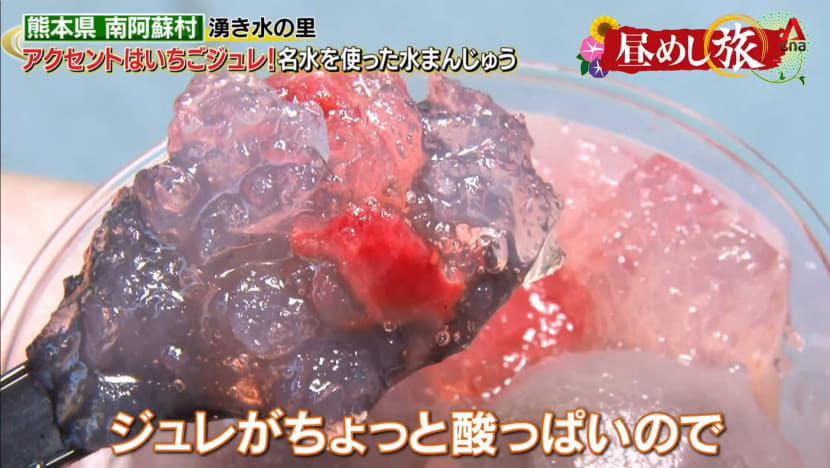It's Lunchtime - Minamiaso Village
A trip to Minamiaso Village - known for its great spring water - and a hot spring town to try a restaurant's popular champon and Kumamoto speciality Aka beef bowl are among this week's highlights.

Join us on our trip around Kumamoto Prefecture this week. Our first stop is Minamiaso Village at the foot of Mount Aso. It is known for its spring water. We start by travelling on the Minamiaso Railway Takamori Line. Many stations along this railway line have names related to water. Furthermore, the Minamiaso Mizu-no-Umareru-Sato Hakusui-Kogen Station, the station with the longest name in Japan, is also located along this line. Minamiaso Railway runs from Tateno Station to Takamori Station and spans about 18km. However, due to the earthquake in Kumamoto in 2016, only five stations - from Nakamatsu to Takamori - are currently operating.
At 10.05am, we board a cute train at Nakamatsu Station. A passenger suggests we alight at Minamiaso Shirakawasuigen Station if we want to visit spring sources. The area is surrounded by mountains, with many rice fields. After walking for 20 minutes, we come across a local who tells us about Shirakawa Suigen, with its subterranean water from Mount Aso. It was previously used as an irrigation pond for many years, but it was turned into a park in 2004. Many people fill up their bottles with the water to take home. The water is very clear and tastes good. Some people would even wash their vegetables using the water.
We find out that these spring sources have been around since the old days. Even when the earthquake hit and tap water was cut off, the water continued to spring out from various places. Of the 11 spring sources in the village, Shirakawa Suigen is the biggest one. About 60 tonnes of water springs out per minute and the water temperature is 14 degrees throughout the year. In recent years, Shirakawa Suigen has also become a popular spot as a spiritual site.
A famous sweet treat in the village is mizutama, a type of mizu manju which is made with water from Shirakawa Suigen. It has coarse red bean paste inside and is served with strawberry agar jelly. The sweet bean paste and sour jelly go well together.
There are many traditional houses in this area and one of the residents mentions a few other spring sources - Kawajigo, Terazaka and Wakisawatsu. Of the many spring sources in Minamiaso Village, 10 of them have been selected by the Ministry of the Environment as being among the 100 best spring waters in Japan. We continue exploring the village and come across another spring source next to a house. It is the home of rice farmer Kazuyuki Fujimoto and his wife Fumiko, both of whom are 68. They agree to let us see their dinner.
We watch Mrs Fujimoto preparing the meal. Koshihikari rice harvested by Mr Fujimoto, grown in the subterranean water of Mount Aso, has a sweeter taste. The rice cooked with spring water is later eaten with stir-fried takana. Mrs Fujimoto also makes potatoes and bacon stir fried with homegrown perilla leaves, salad with cucumber and cabbage harvested from their garden, and pickled cucumber and seaweed. Other dishes include a soup made by simmering chicken, potatoes, konnyaku, shiitake mushrooms, burdock roots and carrots, and adding soy sauce, Nekobudashi, a seasoning made from Hokkaido’s Hidaka kelp and tofu.
Our next destination is Aso Uchinomaki Onsen, 40 minutes away from Shirakawa Suigen by car. We visit a restaurant, Imakin Shokudo, which is famous for its champon. It was founded in 1910. We meet Satoshi Imamura, the manager, and he agrees to let us see how the champon is cooked. Eleven ingredients are used, including Chinese cabbage, shrimp and clams. What makes this champon popular is the restaurant's original Japanese broth. Though champon is commonly served with pork bone soup, this restaurant’s soup is made with kelp and dried small sardines.
But these days, the restaurant’s most popular dish is Kumamoto speciality Aka beef bowl. Aka beef is Japanese beef which originated in Kumamoto in the Taisho period. It is known for its lean and tender meat. The restaurant uses 120g of red thigh meat for the rice bowl. The soy sauce-based sauce is simmered with five kinds of vegetables including onion and radish. The rice is Tsuyahime, which is grown in the spring water of Aso. The rice, which is milled in the restaurant every day, is topped with radish, mizuna and Aka beef.
We are allowed to see what the restaurant’s staff eat for their meals. We are taken to the restaurant’s second kitchen where the owner’s mum, 77-year-old Sawako Imamura, cooks employees’ meals. She cooks for up to 20 people at times. We watch her making potatoes with spicy cod roe; deep-fried aubergines; aubergines cooked with chilli and local summer vegetables; Aka beef; and a soup with ingredients such as bamboo shoots, chicken, carrots and tofu. The soup uses the same soup stock as the restaurant’s champon.
We find out from Mrs Tomomi, the wife of fourth-generation owner Satoshi, that Imakin Shokudo started as a restaurant for local workers. Due to a merger of municipalities in 2005, the town hall and agricultural cooperative moved to the neigbouring town and this affected sales. To keep the restaurant going, Satoshi wanted to attract tourists, so he decided to serve a hearty meal made with Aso's speciality and created the Aka beef bowl.
Tips:
1) Shirakawa Suigen, one of the biggest spring sources in Minamiaso Village, is also a popular spiritual site
2) Aka beef is a famous local speciality of Aso in Kumamoto Prefecture












